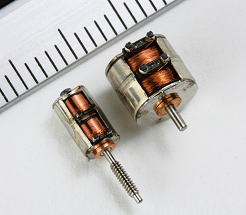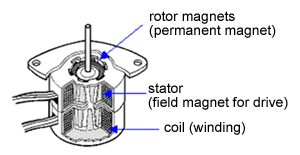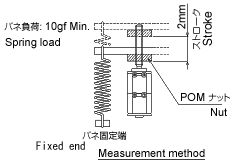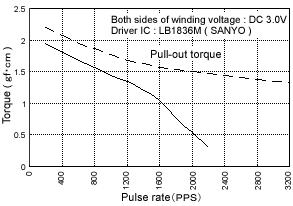2009
May 8, 2009
Minebea Co., Ltd.
Commercialization of High-Resolution, Ultra-small PM-Type Stepping Motors
~ Φ3.3 mm (20 steps) and Φ6 mm (40 steps) are developed by technology fusion ~
Minebea Co., Ltd. ("Minebea") has commercialized two types of world's highest resolution (*based on a research by Minebea) ultra-small permanent magnet-type stepping motors (the "PM stepping motors") (*note1).as mass production models. One is a 20 steps/rotation type with outside diameter of 3.3 mm (the "Φ3mm"), and the other one is the 40 steps/rotation type with an outside diameter of 6 mm (the "Φ6mm").
The Φ3mm, despite with an ultra-small diameter, allows fine positioning of 20 steps per rotation. It aims for adoption in compact, low-profile digital products - such as high-performance cameras for cellular phones (for lens driving) and Blu-ray Disc drives for slim-type notebook computers (for optical pickup) - that was difficult for Minebea's conventional products. The Φ3mm is based on Minebea's 16 steps/rotation PM stepping motors developed in April 2007. It uses Intermediate Cool Magnetization Technology(*note2) (patent publication number: 2006-203173) and Magnetic Circuit Optimization Technology (*note3), both owned by NMB Mechatoronics Co., Ltd. (the former stepping motor business of FDK Corporation, transferred to Minebea in January 2009; "NMB Mechatoronics"). The Φ3mm is commercialized by the technology fusion of both companies.
The Φ6mm achieves high resolution of 40 steps per rotation (conventional products are 20 steps) - the first time in the world as a mass-produced PM stepping motor of the same size. As with theΦ3mm, by using the narrow pitch magnetization rotors with high surface magnetic flux density(*note4)that adopt NMB Mechatoronics' magnetization technology, it allows ultra high fineness and high power torque. The Φ6mm contributes to further heightening the functionality and added value of digital cameras, such as image stabilization; quick auto focuses; and miniaturizing and silencing products by eliminating reduction gears.
The Φ6mm, adopted in lens units for high-performance digital cameras launched this spring, is already mass-produced. Additionally, the Φ3mm is scheduled for start of mass production this autumn.
Minebea positions the Φ3mm and Φ6mm as part of the core products of its small stepping motor business, and aims to expand adoption of both in digital devices that require compact, very fine driving.

Product Photo (Left: Φ3mm, Right: Φ6mm)
Notes
1. Stepping Motors
Stepping motors convert electrical signals into mechanical actions.
The rotation (angle and speed) of stepping motors is controlled by electrical signals (number of pulses) and their frequencies. The number of electrical signals generated determines rotation number. Stepping motors support not only successive rotation but also intermittent driving, variable rotation, positive rotation and negative rotation. They are used in various OA equipment, such as printers and fax machines; PC peripherals; digital devices; precision equipment, etc.
Stepping motors come in three types: PM (permanent magnet), VR (variable reluctance) and HB (hybrid).
PM (Permanent Magnet) Type Stepping Motors
PM-type stepping motors have a rotor part made from permanent magnet. Many magnetic poles are used in the outer region of the rotor, and the driving field (stator) is formed around the poles. PM-type stepping motors are the most popular stepping motors because of the simplicity of the design.
Internal Structure of PM Stepping Motor

2. Intermediate Cool Magnetization Technology
This technology enables precise magnetization by strictly controlling temperatures without relying on conventional pulse currents. It is NMB Mechatoronics' original technology that leads the experience and know-how obtained since the beginning of the development to mass production.
3. Magnetic Circuit Optimization Technology
This technology simulates the optimal shapes, etc. of stator yokes, coils and magnets by using the design know-how that takes advantage of static analysis of magnets and dynamic torque analysis, etc.
4. Narrow Pitch Magnetization Rotors
The use of Intermediate Cool Magnetization Technology enables mass production of very narrow pitch (0.5mm or less) multi-pole magnetization regardless of rotor magnet size. The surface magnetic flux density of narrow pitch magnetization rotors to which this magnetization method applies is at high level that cannot be achieved by magnetization using conventional pulse currents.
Reference
Product Summary of Stepping Motor : Outer Diameter 3.3mm, 20steps motor
| Dimensions (Motor Body) | Outer Diameter Length |
3.3mm (3.4mm Max.) 5.5mm |
|---|---|---|
| Shaft Diameter | - | 0.6mm (There is a lead screw type as a lineup.) |
| Weight | - | 0.24g |
| Steps per revolution | - | 20 (1step=18degrees) |
| Winding resistance | - | 30Ω |
| Maximum starting pulse rate | No load | 4000pps Min. (Operation voltage: DC 3V Both sides of winding, 2 phase on) |
| with spring load | 3000pps Min. (Operation voltage: DC 3V Both sides of winding, 2 phase on) |
|
Lead screw: S1.0xP0.25 |
Product Summary of Stepping Motor : Outer Diameter 6mm, 40steps motor
| Dimensions (Motor Body) | Outer Diameter Length |
6.0 mm (6.2mm MAX.) 5.1 mm |
|---|---|---|
| Shaft Diameter | SM type | 1mm or 0.8mm |
| LA type | M1.4 ~ M1.7 (P0.15 ~ 0.30) | |
| Weight | SM type | 0.75g |
| Steps per revolution | - | 40 (1step=9degrees) |
| Winding resistance | - | 20Ω |
| Maximum starting pulse rate | No load | 2000pps Min. (Operation voltage : DC 3.0V both sides of winding , 2 phase on) |
| Torque characteristics | 2 phase on |  |
| Products Inquiries: | Micro Actuator Sales Management Department TEL 81-3-5434-8732 |
|---|---|
| Media Inquiries: | Minebea Co., Ltd. Corporate Planning Division / Corporate Communications Office TEL 81-3-5434-8637 FAX 81-3-5434-8607 |
Product information, contact and other context are subject to change without prior notice.









